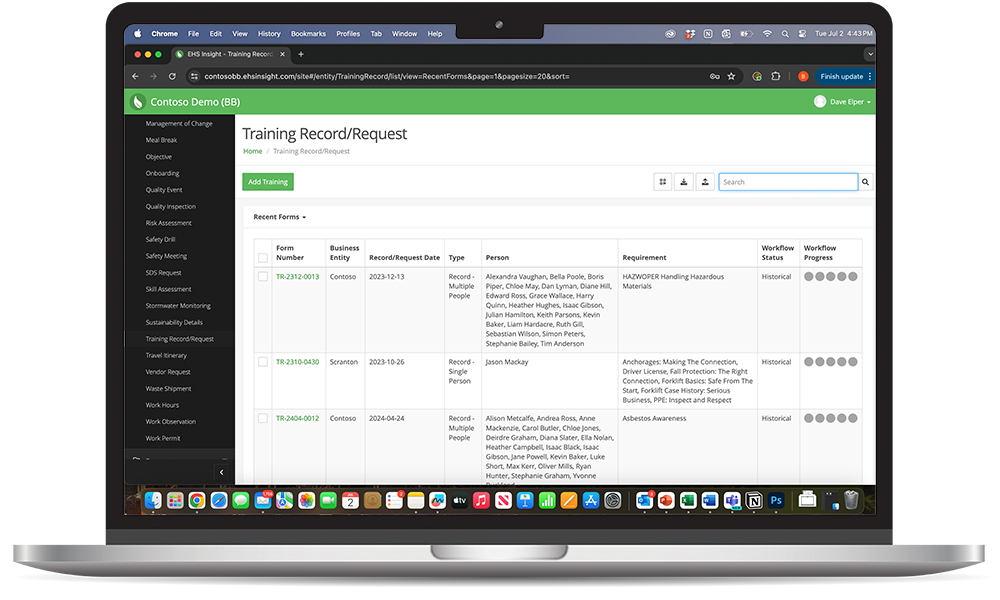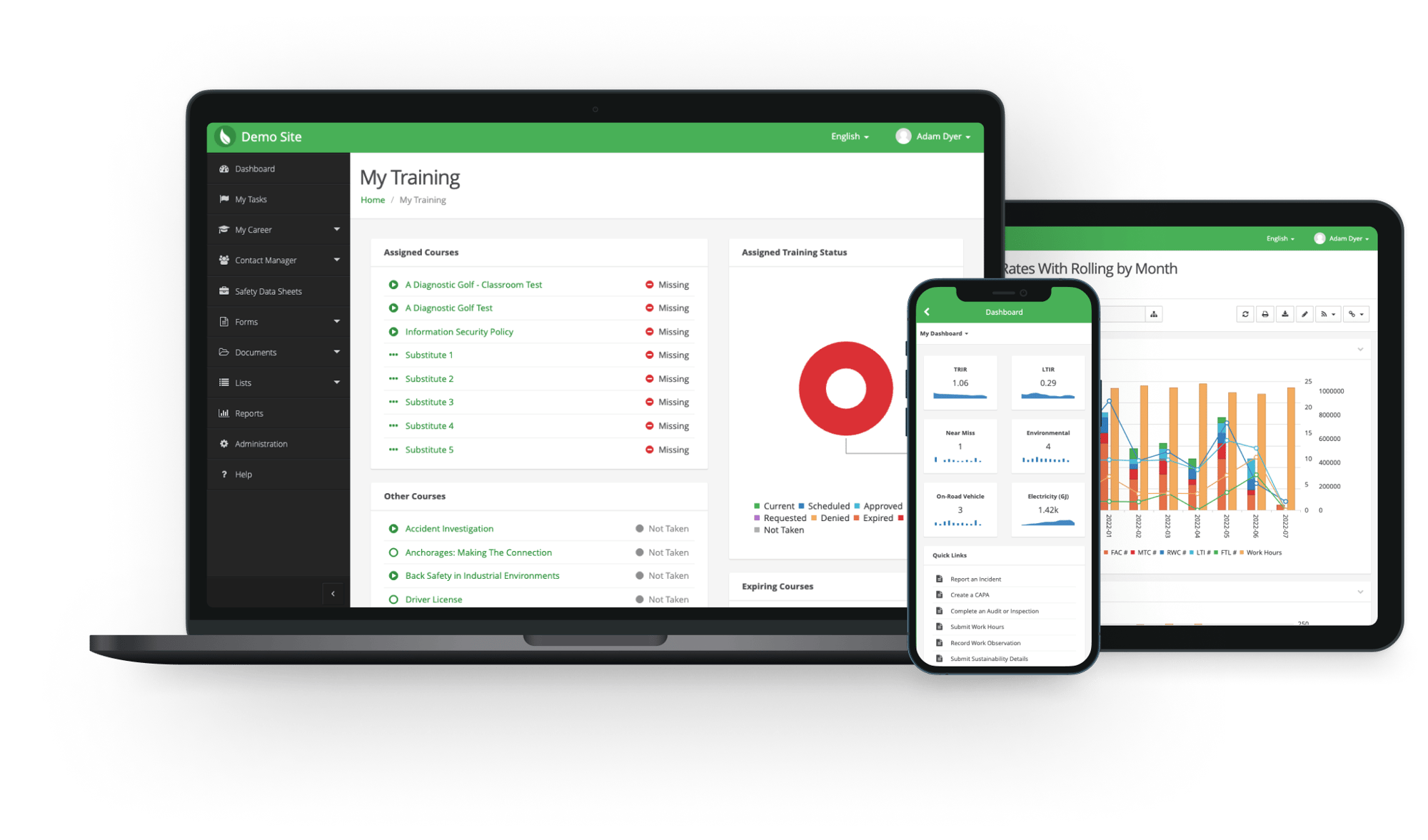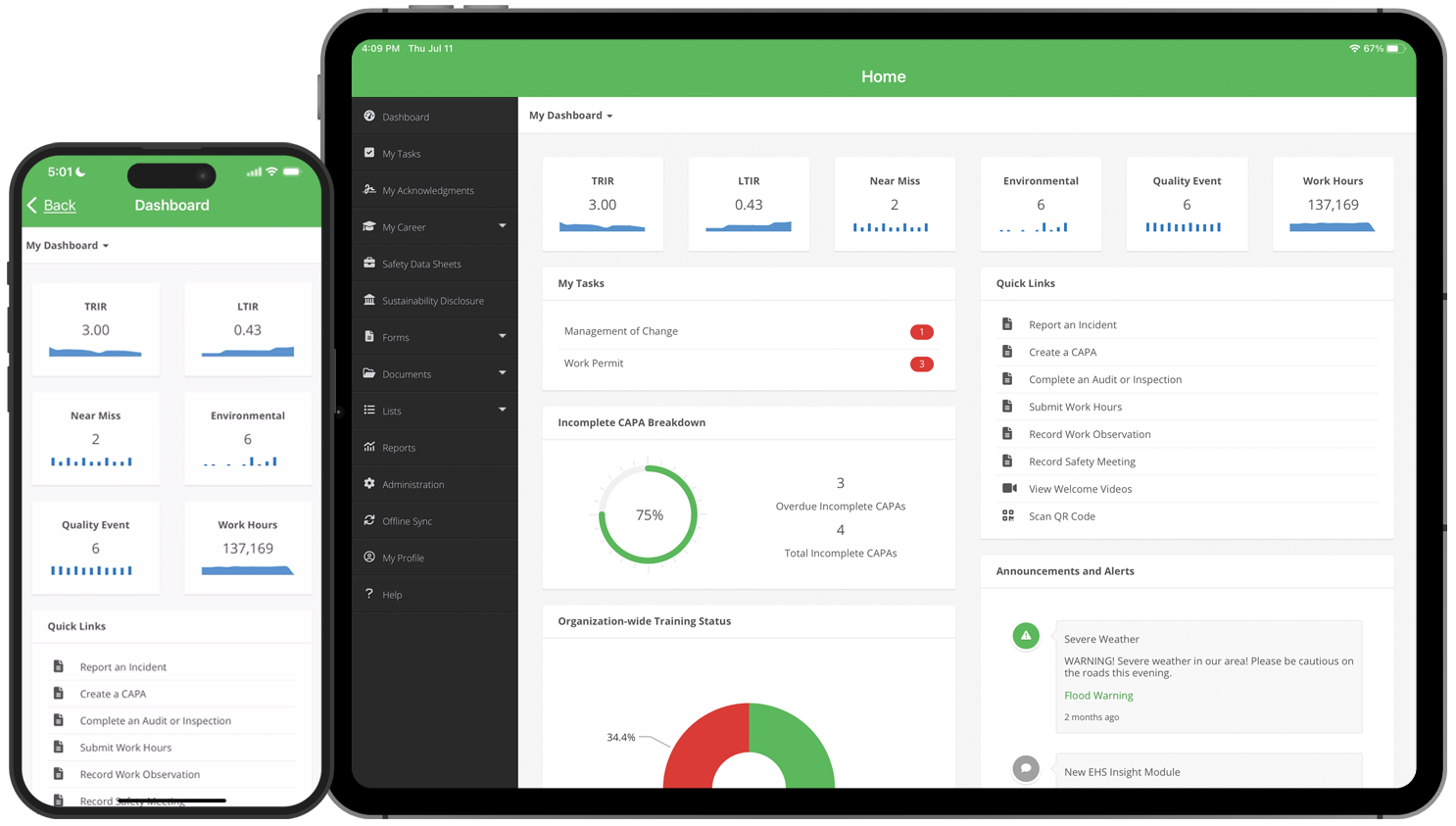Training Management Module
The Training Management Module helps safety professionals achieve compliance with training requirements effortlessly, saving both time and money.
With automated tracking, customizable programs, and real-time reporting, our robust LMS streamlines the entire training process. Experience reduced training-related expenses, minimized administrative burdens, and enhanced overall safety culture and productivity.

Simplify Safety Training. Strengthen Workforce Readiness.
An effective training program is essential for compliance, and for keeping your team safe, informed, and ready for the job. EHS Insight’s Training Management Software makes it easy to deliver, document, and track employee training across every department and location.
With tools for assigning courses, managing certifications, and generating reports, your safety training program becomes more than a checkbox. It becomes a competitive advantage.
Foster Accountability Across Your Organization
Monitor teams' training progress over time, providing a comprehensive solution that displays measurable and trackable learning and development objectives.
These objectives are closely tied to safety and compliance requirements, employee skills, and competency. The module offers real-time visibility into training performance across the entire company and individual personnel, ensuring you can effectively manage and oversee your organization's training initiatives.

Key Features for Smarter EHS Training Management
Customizable Safety Training Assignments
Easily create and assign training based on job roles, locations, compliance needs, or internal requirements. Tailor your program to fit your organization.
Certificate Uploads and Expiration Tracking
Upload, store, and monitor employee certifications in one place. Get automatic alerts before critical credentials expire.
Training Dashboards and Reporting
Track completions, overdue courses, and training effectiveness with real-time dashboards and flexible reporting tools.
Streamlined EHS Reporting and Compliance
Ensure documentation is audit-ready and always up to date. Our system makes it easy to show proof of training during inspections.
Employee Access and Acknowledgments
Give team members access to their assigned training, historical completions, and documentation for acknowledgment and accountability.

Additional Training Management Options

Bring Your Own Content (BYOC)
The Training module, when combined with Bring Your Own Content, supports the ability for admins to upload SCORM/AICC courses that have been created externally, and launch those courses within EHS Insight for users to complete.

MARCOM
When combined with Marcom, the Training module includes BYOC and EHS Insight’s comprehensive library of Online Safety Training Content. This library encompasses a range of courses designed to enhance employee knowledge and compliance with safety protocols and can be seamlessly integrated into your site’s Training Requirements. With interactive courses and assessments, content is engaging, fostering active participation and comprehension.

Microlearning
Modern safety training needs to be fast, effective, and accessible anywhere—especially in high-risk environments. That’s why EHS Insight now includes microlearning: short, focused learning modules designed to reinforce safety knowledge and drive long-term retention.
The Training module, when combined with Bring Your Own Content, supports the ability for admins to upload SCORM/AICC courses that have been created externally, and launch those courses within EHS Insight for users to complete.
When combined with Marcom, the Training module includes BYOC and EHS Insight’s comprehensive library of Online Safety Training Content. This library encompasses a range of courses designed to enhance employee knowledge and compliance with safety protocols and can be seamlessly integrated into your site’s Training Requirements. With interactive courses and assessments, content is engaging, fostering active participation and comprehension.
Modern safety training needs to be fast, effective, and accessible anywhere—especially in high-risk environments. That’s why EHS Insight now includes microlearning: short, focused learning modules designed to reinforce safety knowledge and drive long-term retention.
Comprehensive Online Training Content Library
Our online interactive training makes it possible for you to provide a consistent level of training to each of your employees whatever their schedules or physical locations, and new hires can be trained as soon as they walk in the door.
General Safety
- Accident Investigation
- Active Shooter: Surviving an Attack
- Arc Flash
- Back Safety
- Bullying and Other Disruptive Behavior: for Employees
- Bullying and Other Disruptive Behavior: for Managers and Supervisors
- Compressed Gas Cylinders
- Computer Workstation Safety
- Conflict Resolution in Industrial Facilities
- Conflict Resolution in the Office
- Crane Safety
- Dealing with Drug and Alcohol Abuse... for Employees
- Dealing with Drug and Alcohol Abuse... for Managers and Supervisors
- Dealing With Hazardous Spills
- Distracted Driving
- Driving Defensively
- Driving Safety
- Driving Safety: The Basics
- Electrical Safety
- Evacuation Procedures
- Eye Safety
- Fall Protection
- Fire Prevention in Healthcare
- Fire Prevention in the Office
- First Aid
- Fitness and Wellness
- Hand and Power Tool Safety
- Hand, Wrist and Finger Safety
- Handling A Sexual Harassment Investigation
- Hazard Recognition
- Hazardous Materials Labels
- Heat Stress
- I2P2: Injury and Illness Prevention Program
- Industrial Ergonomics
- Industrial Fire Prevention
- Ladder Safety
- Machine Guard Safety
- Materials Handling Safety
- Office Ergonomics
- Office Safety
- Rigging Safety
- Safe Lifting
- Safety Audits
- Safety Awareness for New Employees
- Safety Housekeeping and Accident Prevention
- Safety Orientation
- Safety Showers and Eye Washes
- Sexual Harassment for Employees
- Sexual Harassment for Managers and Supervisors
- Slips, Trips and Falls
- Using Fire Extinguishers
- Walking and Working Surfaces
- Warehouse Safety
- Welding Safety
- Winter Safety
- Workplace Harassment in Industrial Facilities
- Workplace Harassment in the Office
- Workplace Stress
- Workplace Violence
Regulatory Compliance
- OSHA Recordkeeping for Employees
- Lock-Out/Tag-Out
- Introduction to GHS
- GHS Safety Data Sheets
- GHS Container Labeling
- Hazard Communication in Industrial Facilities
- Hazard Communication in Auto Service Facilities
- Hazard Communication in Cleaning and Maintenance Facilities
- Hazard Communication in Healthcare Facilities
- Hazard Communication in the Hospitality Industry
- Aerial Lifts in Industrial and Construction Environments
- Scissor Lifts in Industrial and Construction Environments
- DOT HAZMAT General Awareness
- DOT HAZMAT Safety Training
- DOT HAZMAT Security Awareness
- DOT In-Depth HAZMAT Security
- Emergency Planning
- OSHA Recordkeeping for Managers and Supervisors
- Bloodborne Pathogens in Commercial and Industrial Facilities
- Bloodborne Pathogens in First Response Environments
- Bloodborne Pathogens in Healthcare Facilities
- Confined Space Entry
- Personal Protective Equipment
- Forklift/Powered Industrial Truck Safety
- Forklift Safety: Industrial Counterbalance Lift Trucks
- Asbestos Awareness
- Tuberculosis in the Healthcare Environment
- HIPAA Rules and Compliance
- Lead Exposure in General Industry
- Respiratory Protection and Safety
- Introduction to OSHA
- Indoor Air Quality
- Hearing Conservation and Safety
- Suspended Scaffolding Safety
- Supported Scaffolding Safety
Construction Safety
- Supported Scaffolding Safety in Construction Environments
- Suspended Scaffolding Safety in Construction Environments
- Hand and Power Tool Safety in Construction Environments
- Hand, Wrist and Finger Safety in Construction Environments
- Eye Safety in Construction Environments
- First Aid in Construction Environments
- Ladder Safety in Construction Environments
- Heat Stress in Construction Environments
- Crane Safety in Construction Environments
- Rigging Safety in Construction Environments
- Slips, Trips and Falls in Construction Environments
- Dealing with Drug and Alcohol Abuse for Employees in Construction Environments
- Dealing with Drug and Alcohol Abuse for Managers and Supervisors in Construction Environments
- Electrocution Hazards in Construction Part I
- Electrocution Hazards in Construction Part II
- GHS Labeling in Construction Environments
- GHS Safety Data Sheets in Construction Environments
- Hazard Communication in Construction Environments
- Introduction to GHS for Construction Workers
- Safety Orientation in Construction Environments
- Safe Lifting in Construction Environments
- Walking and Working Surfaces in Construction Environments
- Personal Protective Equipment in Construction Environments
- Fall Protection in Construction Environments
- Trenching and Shoring Safety in Construction Environments
- Lead Exposure in Construction Environments
- Caught-In/Between Hazards in Construction Environments
- Struck-By Hazards in Construction Environments
Food Safety
- Back Safety in Food Processing and Handling Environments
- Cleaning and Sanitizing in Food Processing and Handling Environments Part I - Cleaning
- Cleaning and Sanitizing in Food Processing and Handling Environments Part II - Sanitizing
- Diversity, Equity, Inclusion and Belonging in Food Processing and Handling Environments
- Emergency Planning in Food Processing and Handling Environments
- Food Handling Safety
- Good Manufacturing Practices in the Food Industry Part I
- Good Manufacturing Practices in the Food Industry Part II
- HACCP… Hazard Analysis and Critical Control Points in the Food Industry
- Safe Lifting in Food Processing and Handling Environments course
- Safety Housekeeping and Accident Prevention in Food Processing and Handling Environments
- Safety Orientation in Food Processing and Handling Environments
- Slips, Trips and Falls in Food Processing and Handling Environments
- Workplace Violence in Food Processing and Handling Environments
Laboratory Safety
- Electrical Safety in the Laboratory
- Flammables and Explosives in the Laboratory
- GHS Safety Data Sheets in the Laboratory
- Handling Compressed Gas Cylinders in the Laboratory
- Laboratory Ergonomics
- Laboratory Hoods
- Orientation to Laboratory Safety
- OSHA Formaldehyde Standard
- Planning for Laboratory Emergencies
- Preventing Contamination in the Laboratory
- Safe Handling of Laboratory Glassware
- Safety Showers and Eye Washes in the Laboratory
Office Safety
- Back Safety in Office Environments
- Computer Workstation Safety
- Conflict Resolution in the Office
- Diversity, Equity, Inclusion and Belonging in Office Environments
- Emergency Planning in Office Environments
- Fire Prevention in the Office
- Office Ergonomics
- Office Safety
- Safe Lifting in Office Environments course
- Safety Housekeeping and Accident Prevention in Office Environments
- Safety Orientation in Office Environments
- Slips, Trips, and Falls in Office Environments
- Workplace Harassment in the Office
- Workplace Violence in Office Environments
Healthcare Safety
- Accident Investigation
- Back Safety in Healthcare Environments for Medical Personnel
- Back Safety in Healthcare Environments for Office and Maintenance Personnel
- Bloodborne Pathogens in First Response Environments
- Bloodborne Pathogens in Healthcare Facilities
- COVID-19 in Healthcare Environments
- Diversity, Equity, Inclusion and Belonging in Healthcare Environments
- Fire Prevention in Healthcare Facilities
- Hazard Communication in Healthcare Environments
- HIPAA Rules and Compliance
- Infection Control in Healthcare Environments for Medical Personnel
- Infection Control in Healthcare Environments for Office and Facilities Personnel
- Patient Handling Safety
- Safe Lifting in Healthcare Environments for Medical Personnel course
- Safe Lifting in Healthcare Environments for Office and Maintenance Personnel
- Safety Housekeeping and Accident Prevention in Healthcare Environments for Office and Facilities Personnel
- Slips, Trips, and Falls in Healthcare Environments
- Tuberculosis
- Walking and Working Surfaces in Healthcare Environments for Office and Maintenance Personnel
- Workplace Violence in Healthcare Environments
- Workplace Violence in Healthcare Facilities
Transportation and Warehouse Safety
- Back Safety in Transportation and Warehouse Environments
- Backing Basics and Alley Dock Backing and Parking for CMV Drivers
- Backing Basics and Straight Line, Offset and Parallel Parking for CMV Drivers
- Defensive Driving
- Distracted Driving
- Diversity, Equity, Inclusion and Belonging in Transportation and Warehouse Environments
- DOT “Reasonable Suspicion” Testing Overview for Managers and Supervisors
- DOT Cargo Securement
- DOT Commercial Motor Vehicle Inspections
- DOT HAZMAT General Awareness
- DOT HAZMAT Safety Training
- DOT HAZMAT Security Awareness
- DOT Hours of Service
- DOT In-Depth HAZMAT Security Training
- DOT 'Reasonable Suspicion' Testing for Managers and Supervisors - Part I
- DOT 'Reasonable Suspicion' Testing for Managers and Supervisors - Part II
- Driving Defensively for CDL/Large Vehicle Drivers - Handling Adverse Conditions
- Driving Defensively for CDL/Large Vehicle Drivers - The Basics
- Drug and Alcohol Testing for CDL Drivers
- Emergency Planning in Transportation and Warehouse Environments
- Injury Prevention for CDL Drivers
- Fatigue and Its Effects for CMV Drivers
- Safe Lifting in Transportation and Warehouse Environments
- Personal Safety for CMV Drivers
- Preventing and Managing Fatigue for CMV Drivers
- Safety Housekeeping and Accident Prevention in Transportation and Warehouse Environments
- Safety Orientation in Transportation and Warehouse Environments
- Slips, Trips and Falls in Transportation and Warehouse Environments
- Walking and Working Surfaces in Transportation and Warehouse Environments
- Workplace Violence in Transportation and Warehouse Environments
HAZWOPER
- Accidental Release Measures and Spill Cleanup Procedures
- Dealing with the Media in Emergency Situations
- Decontamination Procedures
- Electrical Safety in HAZMAT Envrionments
- Exposure Monitoring and Medical Surveillance
- Handling Hazardous Materials
- HAZMAT Labeling
- HAZWOPER Confined Space Entry
- HAZWOPER Fire Prevention
- HAZWOPER Heat Stress
- HAZWOPER Personal Protective Equipment
- HAZWOPER Safety Orientation
- Introduction to HAZWOPER Retraining
- Medical Surveillance Programs
- Monitoring Procedures and Equipment
- Personal Protective Equipment and Decontamination Procedures
- Respiratory Protection and Safety
- Safety Data Sheets in HAZWOPER Environments
- Site Safety and Health Plan
- The Emergency Response Plan
- Understanding Chemical Hazards
- Understanding HAZWOPER
- Work Practices and Engineering Controls
The Benefits of EHS Insight's Training Management

Provide Interactive Training Content

Ensure Training Requirements
Assign training courses throughout your workforce. Easily assign training requirements directly to workers, or assign by job role and location, to be sure compliance-required training is completed. Associate refreshers with other requirements to keep workers current with less time in the classroom.
EHS Insight Saves Time, Saves Money, and Improves Safety Cultures
Training Requirements
A Training Requirement is any organizational need that must be met by one or more employees. These can include courses, certifications, licenses, etc.
There are 3 types of Training Requirements: Online, Traditional, and Substitution.
An Online requirement may be fulfilled by taking an online course within EHS Insight. There are 3 types of Online requirements.
- Simple Course Definition
- SCORM / AICC Package
- SCORM / AICC Reference
A Traditional requirement may represent an in-person course, license, or certification. It is the simplest type of requirement.
A Substitution requirement is met by completing one online or traditional requirement out of several options.
Training Requests
Manage the request, approval, scheduling, coordination, and completion details of a single requirement for multiple individuals. Request that multiple employees undertake the same requirement. Training Coordinators can oversee all aspects for each employee, such as expenses, travel arrangements, and attendance.
Training Records
Capture all the information from the training you have completed (such as requirements) and send in your training requests with care.
Training Test Sessions
Gather a group of individuals to participate in a supervised test simultaneously and in the same place.
What is Microlearning?
Microlearning breaks complex safety topics into bite-sized, engaging lessons that take just minutes to complete. These micro-courses are ideal for reinforcing critical safety procedures, delivering just-in-time training, and improving knowledge retention—especially in industries like oil & gas, construction, and manufacturing.


